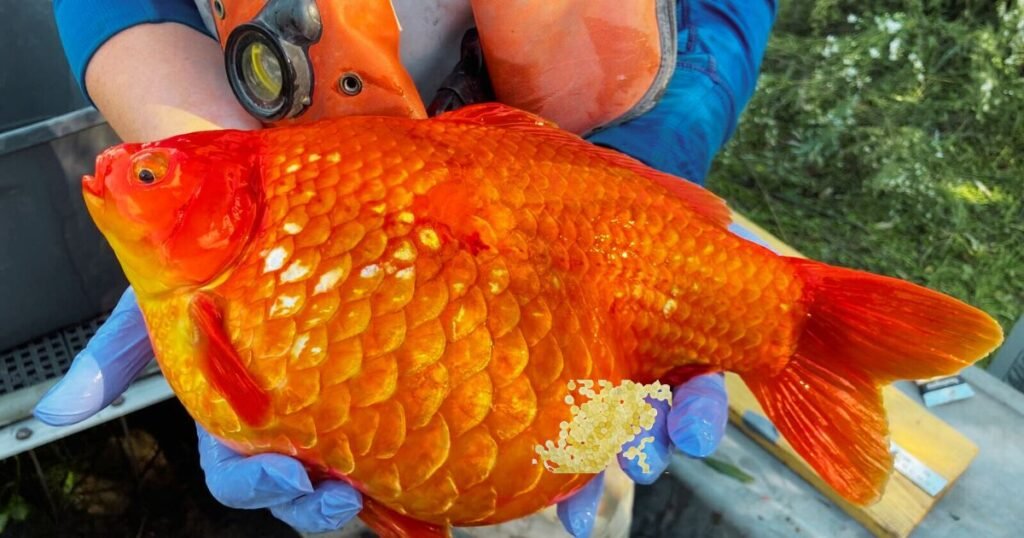Goldfish, with their vibrant colors and graceful movements, have captivated aquarium enthusiasts for centuries. One of the most intriguing aspects of goldfish keeping is the reproduction process, leading to the development of goldfish eggs. In this article, we’ll delve into the fascinating journey of goldfish eggs, exploring their conception, care, and the exciting moment of hatching.
Understanding Goldfish Reproduction
A. Goldfish Breeding Seasons
Goldfish typically exhibit breeding behaviors during the warmer months, with spring and early summer being the peak seasons for reproduction. Understanding the natural breeding cycle helps aquarium owners prepare for potential egg-laying events.
Read More: Lion Headed Goldfish

B. Triggers for Spawning
Factors such as increased water temperature, longer daylight hours, and a well-balanced diet can serve as triggers for goldfish to enter a spawning state. Monitoring these conditions is essential for successful reproduction.
The Egg-Laying Process
A. Selection of Breeding Partners
In a controlled aquarium environment, selecting compatible breeding pairs is crucial. Factors like age, health, and compatibility play a role in determining the success of egg-laying.
B. Courtship Rituals
Goldfish engage in elaborate courtship rituals, including chasing, fin displays, and nudging. These behaviors signify that the female is ready to release her eggs, and the male is prepared to fertilize them.
C. Egg Deposition
The female releases adhesive eggs, which stick to various surfaces within the aquarium. Common choices include plant leaves, decorations, or even the aquarium glass. Providing suitable surfaces for egg attachment is essential for the well-being of the developing embryos.
Care of Goldfish Eggs
A. Protection from Predators
Once the eggs are laid, it’s crucial to protect them from potential predators, including adult goldfish. Separating the eggs from the breeding pair or providing suitable hiding spots can prevent accidental consumption.
B. Monitoring Water Conditions
Maintaining optimal water conditions is paramount during the incubation period. Stable water temperature, appropriate pH levels, and regular water changes contribute to the health and development of goldfish embryos.
C. Hatching Time Frame
Goldfish eggs typically hatch within 48 to 72 hours after fertilization. Observing the eggs closely during this period allows aquarium owners to witness the magical moment when tiny fry emerge.

Caring for Goldfish Fry
A. First Feedings
Once hatched, goldfish fry rely on their yolk sacs for nourishment initially. As the yolk sacs deplete, introducing specialized fry food becomes crucial for their continued growth.
B. Separation from Adults
To prevent potential harm from adult goldfish, it’s advisable to separate the fry into a dedicated tank. This allows them to grow and develop without the risk of being consumed by larger fish.
C. Gradual Introduction to Regular Diet
As the fry mature, transitioning them to a regular goldfish diet is essential. Starting with finely crushed flakes and gradually introducing larger food particles ensures their nutritional needs are met.
The Joy of Goldfish Parenthood
A. Observing Fry Development
Watching the gradual development of goldfish fry, from tiny translucent beings to miniature replicas of their adult counterparts, is a rewarding experience for aquarium enthusiasts.
B. Bonding with the Next Generation
Caring for goldfish eggs and witnessing the hatching process fosters a unique connection between aquarium owners and the aquatic life in their care. It adds an extra layer of joy to the hobby of goldfish keeping.
Conclusion
In conclusion, the journey from goldfish eggs to hatching is a mesmerizing process that showcases the wonders of aquatic life. Understanding the intricacies of goldfish reproduction and providing attentive care during each stage contributes to the overall well-being and success of the aquarium ecosystem.

Read More: Goldfish Eggs
FAQs
Q: How many eggs can a goldfish lay at once?
A: The number of eggs laid by a goldfish can vary, but it can range from a few hundred to several thousand, depending on the species and age.
Q: Do all goldfish lay eggs during breeding season?
A: Not necessarily. While many goldfish may exhibit breeding behaviors, not all individuals will successfully lay eggs, especially if specific conditions are not met.
Q: Can goldfish lay eggs without a mate?
A: Goldfish typically require a mate for successful reproduction. The presence of both male and female fish is necessary for fertilization.
Q: How long does it take for goldfish eggs to hatch?
A: Goldfish eggs usually hatch within 48 to 72 hours after being fertilized.
Q: Is it possible to breed different types of goldfish together?
A: While it’s possible, breeding different types of goldfish may result in hybrid offspring. Careful consideration should be given to the compatibility and characteristics of the parent fish.










